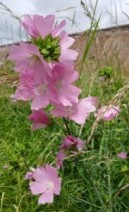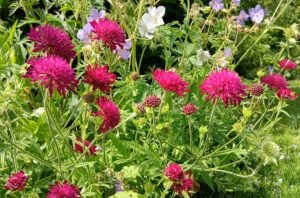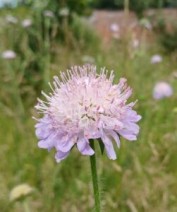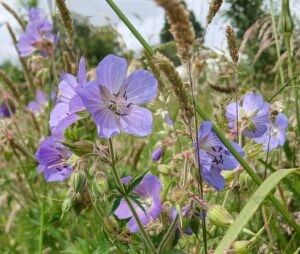Garden Blog - Jul '24
High summer, for gardeners, is most certainly a busy time of year. We’re engaged in a seemingly never-ending cycle of watering and feeding our pots, urns and bedding displays; mowing and edging lawns; deadheading and weeding borders, clipping hedges along with watering, feeding, and deadheading our houseplants to keep them in order. Although these tasks are essential to keep our gardens looking in tip-top condition, they do rather consume life.
Therefore, it’s well worth noting the words of Hans Christian Anderson, well known Danish author of yesteryear, who opined that “Just living is not enough… one must have sunshine, freedom, and a little flower.”
Most surely, among the most charming of ‘little flowers’ are wildflowers, with their freedom to live wherever they chose, and bask in the summer sunshine for both their and our pleasure.
Our Wildflower Orchard is definitely getting into its summer stride right now. Grassy seedheads that sway in the breeze, are dotted with a jewel-like selection of native wildflowers, including musk mallow, meadow cranesbill, chicory, field scabious, and knapweed, attracting all kinds of bees, butterflies, and other pollinators to partake of their offerings.
Of course, native wildflowers don’t have to be restricted to wilder parts of the garden, many are also well suited to formal areas, too. A prime example is Viper’s Bugloss, known to the botanically minded as Echium vulgare, which is an important part of our Parterre display. Viper’s bugloss is an annual if grown from seed under glass, or a biennial if self-sown in the garden. Growing up to three foot in height, viper’s bugloss has flowers that start are pinkish when in bud, but open to reveal strikingly beautiful blue flowers with pink stamens. According to Nicholas Culpepper, in his famed ‘Complete Herbal’ of 1563, “After the flowers are fallen, the seeds growing to be ripe, are blackish, cornered and pointed somewhat like the head of a viper.” This is perhaps where viper’s bugloss got its common name. Medicinally, it was used to provoke a sweat, and along with its diuretic properties was said to help the body expel toxins. Another popular use was as a poultice for healing boils!
Countless wildflowers from across the globe are also grown in British gardens as ornamental plants. A particularly good one, gracing our Long Borders right now, is Knautia macedonica, otherwise known as the Macedonian scabious. Native to Southeastern Europe, including North Macedonia, Albania, Bulgaria, Greece, southeastern Romania, and parts of Turkey, this herbaceous perennial produces a mass of pincushion flowerheads in a rich shade of red, held aloft on slender upright stems throughout summer. As an added bonus it self-seeds with ease, meaning lots of free plants!
On that cheery note, until next month, happy gardening.







